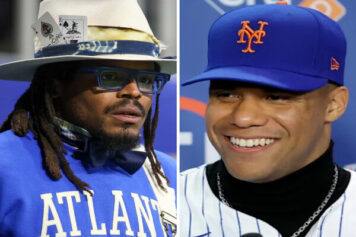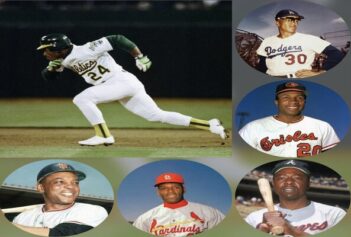The late ‘80s group Soul to Soul had a joint where lead singer Caron Wheeler’s powerful first line was: “Back to life. Back to reality.” Well that’s the tune baseball is pumping through its speakers as it transitions from the offensive mutation called “The Steroid Era” into a new “Pitcher’s Paradise”.
The 2012 MLB Playoffs has ushered in this new pitching-dominant era with authority. The World Series is a battle between the pitch potent, light-lumbered, San Francisco Giants, and the golden arms of the Detroit Tigers. On this World Series stage, stud pitchers will dictate the flow of the show.
Detroit’s postseason pitching has been classic like Jurassic. The Yankees .157 ALCS batting average was the lowest recorded in the franchise's extensive postseason history. The Tigers starters were money in the ALCS, allowing just two runs in 27 1/3 innings. In nine postseason games, the starters’ ERA is a sick 1.02.
Front-end dudes, Verlander and Max Scherzer, are a combined 4 -0 with a .078 ERA. Compared to Verlander — in the words of rapper Drake — the rest of the rotation may “look light, but (they) heavy though.” Doug Fister used his wicked slider-sinker-cutter combo to pitch 6 1/3 shutout innings in the ALCS and has a 1.35 ERA in two postseason starts. Anibal Sanchez, who already has a no-hitter on his resume, is 1-1 with a 1.35 ERA in two postseason starts and pitched seven shutout innings to beat the Yankees in Game 2.
The Giants haven’t peaked as a staff, but when faced with elimination, they have shown flashes of the dominance that helped them capture the 2010 World Series. Former Cy Young winner Tim “The Freak”Lincecum is an 11k, one-hit moment waiting to happen. NL Cy Young candidate Matt Cain has lights-out stuff. Ryan “Big Game” Vogelsong, has blossomed in this playoffs, winning a huge ALCS Game 6. And 10 years after winning the Cy Young, veteran Barry Zito, hopped in a time machine and told St. Louis to fall back in Game 5. Zito has the unenviable task of locking horns with Verlander in Game 1.
The heightened pressure of every playoff- pitch and the increased importance of each run make the WS a must-see for sports fans. Nail-biting pitchers’ duels highlight the value, intrigue and excitement of low-scoring games. Taking the juice out of baseball has put the authentic spark back into it.
In the past half decade, MLB hurlers have regained their Mojo, throwing us back to the pitching-rich seasons of Bullet Bob Gibson and Sandy Koufax. The elimination of rampant steroid use is the biggest reason. Harsher penalties and public humiliation have been a major deterrent to PED use in baseball. In 2006, suspensions for a positive drug test, was increased from 10 to 50 games. The Bud Selig-commissioned Mitchell Report in ’07 exposed the epidemic, and damaged the reputations of baseball’s biggest stars. Some were even dragged in front of Congress and exposed as liars.
In the early 1990’s the effects of steroids and performance enhancers hit baseball like a tsunami. Like when crack hit the streets of Oaktown in the 80s. Player usage exploded after the MLB strike of 1994. Homeruns swelled to an average of 177 per game by 1996. That number dwarfed the 126 per game average during the last clean era of baseball–from 1978 to about 1990, when Hall of Famers like Dave Winfield, George Brett, Eddie Murray and Mike Schmidt put up “official” power numbers.
The days of Klitschko brothers-looking, 60-homer–hitting droids are over. Just peep how the numbers have flipped since 2000, when nobody threw a no-hitter. This season pitchers were “making it rain” like Lil’ Wayne, racking up seven no-hitters and three perfect games. Cain, the starter in San Francisco’s Game 7 shutout, tossed one of those gems. Other dope pitching accomplishments included knuckleballer R.A. Dickey’s Mets- record 44 2/3 innings without allowing an earned run; and Tampa Rays closer Fernando Rodney setting the Major League record for the lowest ERA with at least 50 appearances (0.60). Rodney broke the record of 0.61 that was set by Dennis Eckersley in 1990
In Y2K there was a whopping 5,693 homers hit in MLB. This season homers have plummeted to 4,934. That’s almost 800 less dingers. In 2000, Sammy Sosa led baseball with 50 homers. At least 10 other players hit 40 that season. By 2008, MLB’s top slugger Miguel Cabrera led baseball with just 37 homeruns, and in 2009, Mark Teixeira and Carlos Pena tied for the lead with 39 home runs. These were the lowest totals for a homerun king since 1989. Runs are also down significantly from 2000 when 24,971 players crossed home plate. This season, just 21,017 runs were scored. With the decrease in offense, naturally pitching ERA’s dropped nearly a run, from 4.77 to 4.01.
The death of steroids isn’t the only factor in baseball’s pitching renaissance. More cats are throwing 90 plus mph darts these days, making life much harder on hitters. FanGraphs ranked all of the pitchers who threw at least 30 innings in a season and their average fastball velocities. The number of pitchers with an average fastball velocity of 95-plus has steadily risen from 11 in 2007 to 35 in just five years. An endless parade of flamethrowers have hit the mound in these playoffs, as evidenced by the high strike out rate.
The expanded pitching repertoire is another reason. Back in the day, most great pitchers had one or two pitches. Now, any average pitcher probably has an array of four pitches he can dial up at any time.
Mixing pitches and speeds keeps the best hitters off balance. Vogelsong executed this to perfection against the Cardinals in the NLCS. According to BrooksBaseball.net, Vogelsong, a 35-year-old finesse pitcher, had five pitches poppin’against the Cardinals – a four and two-seam fastball, changeup, slider and curveball. His extensive pitch package has helped him to a 1.42 ERA in his three postseason appearances.
The “Pitcher’s Paradise” era is dominated by information and mathematical formulas designed to give managers, pitchers and catchers, an edge on every pitch. Old-school managers like Detroit’s Jim Leyland tend to go with their gut, and rely less on sabermetrics and dizzying numbers. The use of tracked information and studying statistical trends has also played a vital role in the rise of the pitcher. New-age managers like Joe Girardi, are constantly scouring their notes for a strategic advantage. Girardi’s binder holds info on a hitter’s strength and weaknesses and offers a script on how to get players out.
The future of baseball is a bright mix of skilled hitters and pitchers playing a high-stakes game of 60-feet 6 inch-chess. When a hitter is at his best, he’ll get his base knocks, but the pitcher remains the most influential position in a baseball game. If you love the science of pitching and softball scores just don’t sit right, flip on the TV tonight. Baseball’s “Pitcher’s Paradise”era will be on full display.



